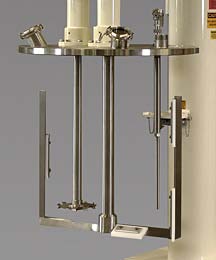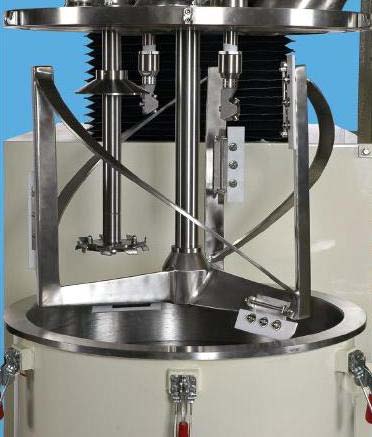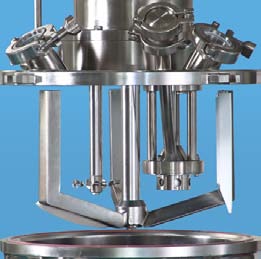Tech Report
Choosing the right anchor agitator for your multi-shaft mixer

Technology Brief
Multi-shaft mixers are typically equipped with a low-speed anchor agitator which promotes laminar bulk flow and uniform batch temperature. Optimizing the design of this anchor agitator helps to ensure maximum mixing efficiency and processing flexibility.
Optimizing multi-shaft mixer design
Multi-shaft mixers are comprised of two or more independently-driven agitators working in tandem. A low speed anchor compliments one or two high shear devices, such as a sawtooth disc-style disperser blade or a rotor/stator assembly.Various agitator combinations are supplied depending on the specific application.
When designed properly, a multi-shaft mixer can handle formulations as high asa million centipoise. In fact, optimizing the mixing system for operation near the high end of its viscosity range has become a common necessity in recent years as many industries trend toward higher viscosities in their process lines.Environmental regulations seeking to minimize emission of volatile organic compounds (VOCs) have encouraged companies to reduce or eliminate solvents from many products. This creates higher solids content and increased viscosity.At the same time, many manufacturers are finding that their efforts to meet customer demand for improved product performance are also driving their formulations toward higher viscosities.
As a result, agitator drives are now typically specified with wide speed ranges to accommodate a broad span of working viscosities in the typical mix cycle.Subtleties in mixer design, such as anchor profiles, have become more important than ever before. The following section discusses some common options for anchor agitators used in multi-shaft mixers.
Anchor agitator options
- Two-wing anchor. This design consists of two vertical "wings" connected by a horizontal flight to a centrally-positioned shaft. The anchor provides a means for agitating product near the vessel surfaces since the bottom horizontal bar and vertical wings run at close proximity to the vessel walls.Product is constantly removed from the sidewalls and bottom, allowing fresh material to continuously rush to these areas.
- Three-wing anchor. The three-wing anchor provides more agitation than the two-design. It also better accommodates helical flights which can be added to enhance top-to-bottom mixing and prevent stratification.
- Helical anchor. To simplify clean-up, the vertical wings in an anchor agitator can be replaced entirely with helical ribbons supported by rings at the top and bottom.
- Flat-bottom. Flat-bottomed vessels are typically the standard for most applications due to their economical design. The anchor agitator follows the internal profile of the mix can, maintaining a tight clearance.
- Dished-bottom. Vessels with dished or hemispherical bottoms are chosen for critical processes because they have a higher surface area to volume ratio and transfer heat better than flat-bottomed tanks. In addition, dished bottom tanks enable complete discharge by gravity and easier clean-up, an important feature for sanitary applications. The anchor agitator is contoured to match the shape of the vessel.
- Scrapers. Removable hinged scrapers may be attached to the anchor agitator in staggered locations to enhance mixing and heat transfer.
Multi-Shaft Mixer Sample Configurations

Dual-Shaft Mixer composed of a two-wing anchor with scrapers and a saw-tooth disperser. A temperature probe through the mixer cover is also shown.

Dual-Shaft Mixer composed of a three-wing anchor with helical flights and scrapers, and a saw-tooth disperser with slinger. Two clean-in-place rotary spray nozzles are also shown.

Triple-Shaft Mixer composed of a three-wing anchor with a toriconical bottom profile, a saw-tooth disperser and a rotor/stator with powder induction manifold.
Sample Application: Flavor Emulsions

Several Ross Multi-Shaft Mixers are being used at flavors manufacturing facility. One application of the Ross Mixers is the preparation of maltodextrin syrup. The starting syrup is cooked off to remove most of the water and an oil flavoring is added to the reduced syrup to produce a viscous flavor emulsion. The emulsion is cooled and extruded into solid pieces that are used as flavor crystals for addition to a variety of food products.
The Ross Multi-Shaft Mixers dedicated to this process have a fixed-tank design.Each unit is capable of operating from full vacuum up to 150 psi internal pressure at 386°F. A two-zone dimple jacket on the vessel sidewall and bottom allows for steam heating. The agitation system consists of a high speed disperser shaft and a three-wing anchor with a triangular cross section contoured to the dished-bottom mix vessel. Helical flights and Teflon scrapers are attached to the three-wing agitator.